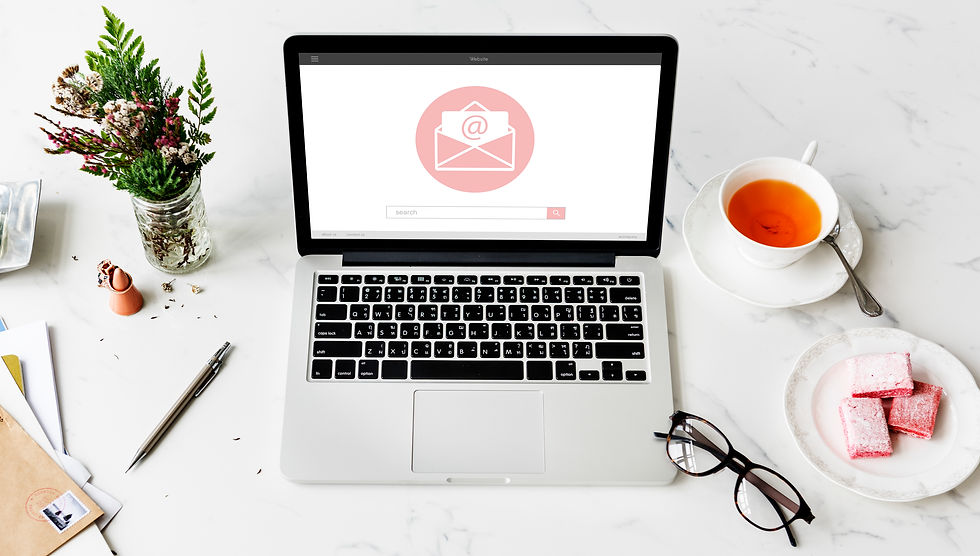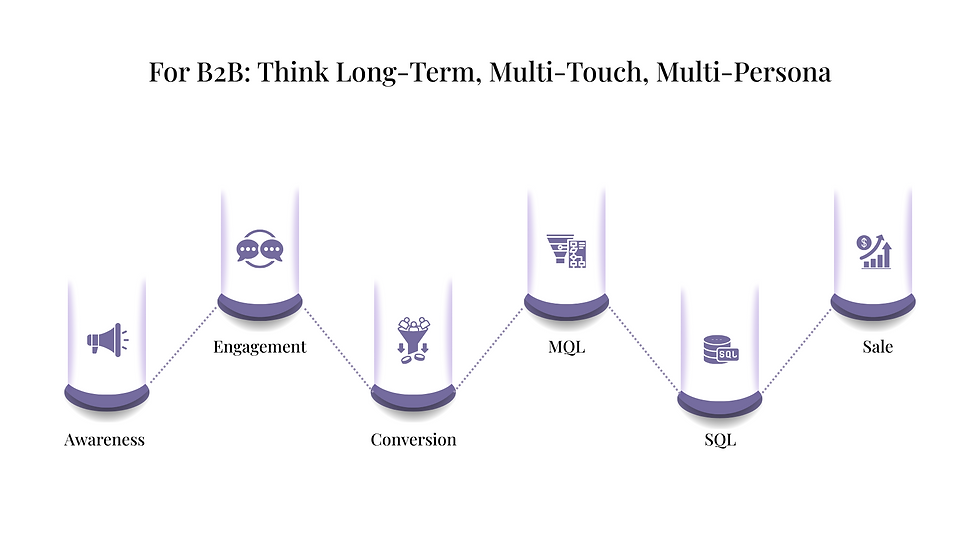The Beginner’s Guide to Lead Nurturing Through Email Marketing
- SKHB
- Jul 22
- 6 min read

So, you’ve got leads. A few names on the list. Some downloads. A handful of “Hey, this looks interesting” DMs. That’s the good news.
The bad news? Leads don’t magically turn into customers just because they downloaded your guide, liked your posts, watched your Reels or booked a discovery call and said, “I’ll think about it.”
If your leads are going cold faster than your half-finished $10 Starbucks vanilla mocha swirl, well… Houston, we have a problem.
In other words, it’s probably not your visibility but your nurture. Most businesses forget this part and treat lead nurturing as an afterthought. Or worse, they think nurture is a single welcome email or a dusty follow-up months later that starts with “Just checking in.” But real lead nurturing is none of those things.
It’s a system. A relationship. A conversation that builds trust long before a sale is made. A way to move people from mildly curious to where do I pay?
And if you’re not doing it intentionally, you’re not just leaving revenue on the table - you’re leaving the relationship behind too.
In this article, we break down how to nurture leads in a way that’s simple, structured, and actually converts.
What Is Lead Nurturing?
Lead nurturing is the process of guiding potential customers through the decision-making journey by providing valuable content, building trust, and showing up consistently.
Not aggressively. Not robotically. But strategically.
Think of it as relationship building. If lead generation is like meeting someone at a party, lead nurturing is what happens after you swap numbers. You don’t immediately pitch a wedding. You keep showing up. You ask good questions. You build credibility. You let them feel like they’re in control of the pace.
And eventually, if the connection is right, they say yes.
Lead Nurturing in B2B vs. B2C: What’s the Difference?
Before we dive deeper into email strategy, let’s pause and get one thing straight - how you nurture a lead depends heavily on the type of industry you serve and who you’re selling to (aka your key customer personas).
If you’re a service provider or consultant working with other businesses (e.g. an email strategist for a tech Saas brand), you’re probably in the B2B camp - even if it’s not stiff and corporate. If you sell a product or course directly to individual consumers, that’s more B2C.
Either way, the heart of nurturing remains the same: be relevant, be consistent, be helpful, and keep showing up.

In the B2B world, lead nurturing is far more nuanced than sending a few emails and hoping for a response. It involves guiding prospects through a layered journey with multiple touchpoints, decision-makers, and stages of consideration. Why?
● Because it often involves multiple stakeholders, priorities, and approval loops before you can officially close the deal.
● B2B buying decisions can take weeks or even months
● In most cases, the content needs to be educational, data-driven, and solution-focused
● B2B nurture involves both marketing automation and sales conversations
Key takeaway: In B2B, nurturing is a shared effort between your marketing and sales team, and it’s all about building long-term trust and proving ROI.

In B2C, the funnel is more direct - but make no mistake, it doesn’t mean it’s simpler. Faster decisions often mean higher expectations, shorter attention spans, and a smaller window to earn trust.
The buying decision is typically made by one person, even if you’re targeting multiple customer segments or personas. That means your messaging needs to speak clearly to the individual, not a committee. Below are some of the key characteristics of a B2C sales cycle:
The buyer is usually one person
The purchase journey is shorter (days or even minutes)
Nurture happens mostly through content, email, and brand experience
Emotional triggers and social proof play a bigger role
Why Email Marketing Is Still the Smartest Way to Nurture
Email might not be as sexy as TikTok or as loud as LinkedIn, but it is intimate, scalable, and algorithm-free.
It’s where leads actually read what you’re saying. It’s where you can build momentum over time. And if you do it right, your email list becomes your highest-converting channel-hands down.
But nurturing with email takes more than blasting updates or writing from a place of panic when your sales are slow. It starts with a structure.
Pro Tip: According to various studies, email marketing delivers an average ROI of $40 for every $1 spent -making it one of the highest-performing channels available. But that return doesn't come from random blasts or last-minute pitches. It comes from intentional, relationship-focused messaging that meets people where they are.
Building an Email Sequence That Feels Like a Conversation
A good nurture sequence isn’t a funnel - it’s a flow. Think of it as a thoughtful conversation where each email earns the right to continue.
You don’t need a dozen emails. You need a few well-crafted ones that build momentum and trust.
Email 1: Warm Welcome and Orientation
This is where you welcome them, affirm their decision to sign up, and set clear expectations. It’s not about being clever. It’s about being clear and human. Tell them what they’ll receive, and why it matters.
Email 2: Mirror the Problem
Before you offer a solution, show them you understand the tension they’re living in. Describe the problem in a way that makes them say, “This person gets it.” No pitches here, just resonance.
Email 3: Offer a Shift in Perspective
This is where you gently introduce a better way. A fresh lens. A new idea or framework. You're not selling yet - you’re expanding what they believe is possible.
Email 4: Prove It’s Real
Use a brief story or case study that shows your process working. Keep it focused on the transformation, not the testimonial.
Email 5: Extend the Next Step
Now you offer the invitation to go deeper. Make the call to action feel natural, not obligatory. Whether it’s booking a call or exploring a paid offer, make it easy to say yes.
From Stranger to Superfan: The Real Customer Journey
No one wakes up and decides to hand you their credit card out of the blue. First, they lurk. Then they listen. Then, if you’ve done your job right, they lean in.
Then buying experience is rarely logical at first - it’s emotional. And your job as a marketer isn’t to push people through a funnel. It’s to walk beside them, step by step, until they feel safe enough to say yes.
Here’s what that usually looks like in real life:
Stage 1: “Something’s Off…”
They’re not shopping yet, they’re searching. They feel the friction in their business, their health, or their life, but they can’t name the problem clearly. This is your chance to meet them with empathy, not solutions.
Stage 2: “Wait…There’s a Better Way?”
Now they realize there are options. Yours might be one of them. They’re comparing tabs, bookmarking content, and quietly judging who feels legit. Here’s where you start to earn trust - not by being louder, but by being clearer and more helpful than anyone else.
Stage 3: “I Keep Seeing You…”
They’ve read your emails. Liked your posts. Maybe even watched your webinar or checked your About page more than once. They know your name, they like your vibe, but they’re still mentally pacing. This is the bridge. Keep showing up with value, not volume.
Stage 4: “Okay, Let’s Talk.”
Now they’re ready. Not because you pushed, but because you patiently showed them the way. This is where clarity, confidence, and a clear next step seals the deal - not a hard pitch.
The point?
Most leads don’t convert because we assume they’re further along than they really are. But if you can design your emails to guide someone from foggy to focused, from “maybe” to “where do I pay,” you’re no longer just selling.
You’re leading.
Final Word: Nurture Is the Business
Too many brands treat nurturing as the afterthought. The follow-up. The thing you scramble to fix when conversions go quiet. But in reality, nurture is the strategy.
It’s the work that earns trust in between clicks and conversations. It’s what separates forgettable brands from the ones people wait for in their inbox. And it’s often the quiet system that powers consistent sales, even when your social content is getting crickets.
So, here’s your next move to building a powerful revenue engine: Map the journey. Write the first email. Show up before they’re ready to buy.
You don’t need to be perfect. You just need to be present.
Your turn: What’s been your biggest challenge (or best win) when it comes to lead nurturing? Leave a comment below - we read every one, and we reply too..




























































Comments